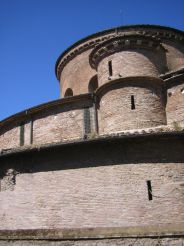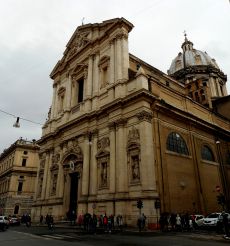Santa Costanza, Roma

The Mausoleum of Santa Costanza in Rome (Mausoleo di Santa Costanza) is the tomb of the daughter of the famous Byzantine emperor Constantine the Great. The tomb is one of the cornerstones of late ancient architecture. Already in the Middle Ages, it was transformed into a church. Today the mausoleum is known among tourists for its mosaics of the 4th century.
History of the mausoleum
The mausoleum was built in 340-345 to be a resting place for the daughter of the emperor of Byzantine. The place was chosen specifically near the burial site of St. Agnes, who was venerated by Constantine.
After several centuries of desolation, the mausoleum was used as the baptistery of the Sant'Agnese church, built next door. And in 1254, after the canonization of Constance, the mausoleum became a separate church dedicated to the saint. This happened thanks to Pope Alexander IV.
In 1620, Cardinal Fabrizio Verallo replaced the ceiling mosaics with frescoes. In the 17th century, Flemish artists gathered here, united in the association “Bentvogels”. And in 1720, Pope Clement XI banned this organization.
In 1992, archaeological excavations were carried out near the mausoleum, after which the church and the tomb were restored.
Architecture
The building is a mixture of early Christian and late Roman architecture. It is based on a round plan. The building is crowned with a dome with a diameter of 22.5 meters, under which there are 12 windows providing lighting. The dome is supported by 12 pairs of columns arranged in a circle and radially connected by composite capitals. The outer row of columns limits the circular corridor, covered with arches. This architectural solution gives a very interesting line between light and dark in the temple.
In the thick outer wall there are many niches, and the porphyry sarcophagus of Costanza was placed in one of them. Today, the latter is located in one of the Vatican Museums. After the mausoleum was transformed into a baptistery, a narthex with two small side apses was added outside. Now only the basis of the baptismal font is preserved.
Mosaics
The walls of the building are decorated with inlaid precious marble. Due to poor preservation the ceiling mosaics were replaced by the corresponding frescoes. The outer circle has illustrations of fishing, and the inner scenes from the Old and New Testaments.

The original 4th century mosaics on the walls of the circular corridor were preserved to this day. Geometric, animal and floral motifs dominate among them. One of the mosaics depicts a woman, and some researchers believe that this is a portrait of Costanza herself. In the two niches of the outer wall there are typical mosaics of the time: the Apostle Peter and Christ the Lawgiver. The latter dates back to 360 and is recognized as the oldest monumental mosaic in Rome.
How to get there
The Mausoleum of Santa Costanza is located in the northeast of the center of Rome, on one of the largest streets in the city, Via Nomentana, 349. The famous Villa Torlonia is situated at some distance. Near the tomb there is a bus stop Nomentana/S. Agnese (routes 66, 84, N4).
Opening hours: every day from 9:00 to 18:00. Phone number for information (+39) 06 86205456.
Free admission.



